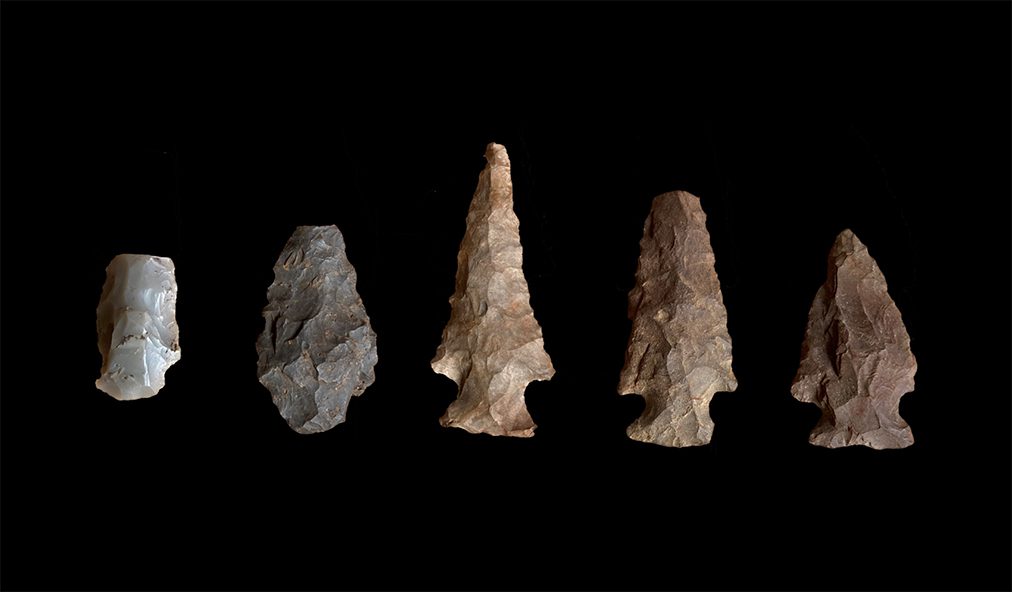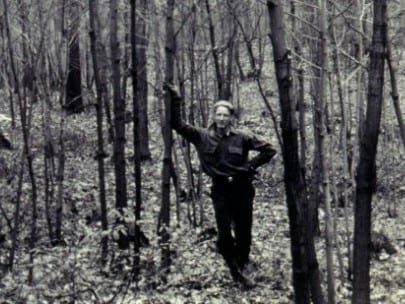Highland Forests: Pleistocene to Present Day
Nearly 14,000 years ago, Pleistocene glaciers retreated and subsequently, forests began to develop in the Hudson Highlands. Paleoecological research at Black Rock Forest documents the establishment of northern conifers, including spruce and fir, during this time period. The conifers were succeeded by hardwoods, including oak and chestnut, as the climate warmed. Over the past 10,000 years, tree species composition in the Highlands has continued to change in response to short- and long-term variations in climate and human activities. For example, average air temperature in the region increased by about 1 degree Celsius during the 20th century, a change that impacted plants and animals. Droughts and extreme weather events have become more common in recent decades.
Indigenous Lands

The lands of Black Rock Forest lie within the traditional territory of the Lenape, who have stewarded this land throughout the generations. As the last glacial period ended about 12,000 years ago, people migrated to the Hudson Highlands and established settlements, practiced intensive hunting, farmed, and used fire as a forest management tool. A history of genocide and systematic displacement began in the mid-1500s with European contact. The remaining communities of Lenape peoples were forcefully removed and displaced to territories west of the Mississippi River after the passage of the Indian Removal Act of 1830.
Today, the Lenape diaspora includes three federally recognized nations in the U.S. and two first nations in Canada: the Delaware Nation of Oklahoma and the Delaware Tribe of Indians, in Oklahoma; the Stockbridge-Munsee Band of Mohican Indians, in Wisconsin; and the Munsee-Delaware Nation and the Delaware Nation at Moraviantown, in Ontario, Canada.
To learn more about these nations and their homeland visit:
A Brief History of the Stockbridge-Munsee of Mohicans
American Revolutionary War Era

The Hudson Valley and the region surrounding Black Rock Forest played a central role in the American Revolution and George Washington’s leadership. A road built through the Forest to provide early passage through the Highlands was quite possibly the primary land route of fleeing soldiers and militia after the fall of Forts Montgomery and Clinton on October 6, 1777.
Archaeological excavations in Black Rock Forest have found military items dating from this period of activity.
To learn more visit:
The Hudson Valley in the American Revolution
Living and working in Black Rock Forest

Since at least the 1690’s, European settlers used Black Rock Forest lands for subsistence farming, livestock grazing, and production of wood products. As reflected in environmental historian Neil Maher’s land use timeline, below, commercial farming and lumbering peaked between 1790 and 1880. Homesteaders cultivated wheat, created orchards, and dairy farmed on Forest lands, while continuing to cut timber for cordwood and charcoal. Some Forest lands were also mined for iron ore. Two of the abandoned mines are still visible today on Whitehorse Mountain and on Sackett Ridge.
Cordwood and charcoal from Black Rock Forest helped supply the region’s iron- and brick-making industries, and demand for these products, as well as tannins from hemlock trees, resulted in repeated clearcutting of Forest lands. Much of the activity during this period was haphazard and uncontrolled, often causing or followed by fires. As a result, the Black Rock Forest area in the early 1900s was degraded, bearing little resemblance to the mature forest we see today.
While many artifacts of the homesteading era remain in Black Rock Forest, there is only one intact structure, the Stone House. This home was built in 1833 by the Kronkite family, which homesteaded 220 acres of surrounding land for three generations. The Stone House is located in the center of the Forest on Continental Road.
Dr. Maher researched the history of more than seventeen Black Rock Forest settlements in a 1994 paper entitled Black Rock’s Hidden Past: A History of Land use Practices Prior to the Creation of Black Rock Forest. To learn more about specific homesteaders’ activities you can read the entire paper.
To learn more visit:
Black Rock Forest’s Archeological Collections (Artifacts found around the forest)
The Early Experimental Forest

In the late 1800s, the Stillman family, drawn by the beauty of the Highlands, began to purchase tracts of mountain land in Cornwall, including homesteaders’ farms that had fallen into disuse. From these lands, Dr. Ernest G. Stillman created Black Rock Forest in 1929, designating it as a resource for forest research and demonstration. Stillman’s forest crew implemented plantings, fertilization trials, and selective logging, and weeded out “undesirable” species. The Forest, much of which had been logged and/or farmed for two centuries, steadily improved in health.
The Calvin Whitney Stillman Research Archive provides a collection of data and papers from this period.
Storm King Mountain & the Environmental Movement

In the 1960s, a plan to build the country’s first pumped storage power plant on neighboring Storm King Mountain posed a threat to Black Rock Forest, much of which was to be submerged under Con Edison’s proposed storage reservoir for the plant. The nationally publicized, twenty-year battle over the proposed Storm King plant is considered by many to be the genesis of the modern environmental movement in the United States. The proceedings were the first in which citizen groups gained legal standing to object to a development on the basis of conservation and environmental impact. The earliest groups to oppose the plant were the New York-New Jersey Trail Conference, which later became a member of the Black Rock Forest Consortium; the Cornwall-on-Hudson Garden Club; the Nature Conservancy; and early founders of the National Resources Defense Council and Scenic Hudson. They were joined by the Garden Club of America, the Sierra Club, the Hudson River Fishermen’s Association, and the Palisades Interstate Parks Commission, among others. Scenic Hudson won a settlement with Con Edison in 1980 and the plant was never built. Several Cornwall-based founders of Scenic Hudson later helped as Black Rock Forest was being established.
To learn more visit:
Marist Environmental History Project
References
Maenza-Gmelch, T.E. 1997. “Holocene vegetation, climate, and fire history of the Hudson Highlands, southeastern New York, USA.” The Holocene 7(1): 25-37.
Maher, N. 1999. “’A very pleasant place to build a towne on:’ an environmental history of land preservation in New York’s Hudson Highlands.” Hudson Valley Regional Review 16(2):21-39.
Raup, H.M. 1938. “Botanical studies in the Black Rock Forest,” Black Rock Forest Bulletin No. 7. Cornwall Press, Cornwall, NY. 161 p.
Schuster, W.S.F. 2011. “Forest Ecology,” Chapter 7 in The Highlands: Critical Resources,Treasured Landscapes, R.G. Lathrop, Jr. Ed., Rutgers University Press, New Brunswick, NJ, p. 132-157.
Trow, G.W.S. 2004. The Harvard Black Rock Forest. University of Iowa Press, Iowa City, Iowa. Tryon, H.H. 1930. “The Black Rock Forest,” Black Rock Forest Bulletin No. 1. Cornwall Press, Cornwall, NY. 42 p.

